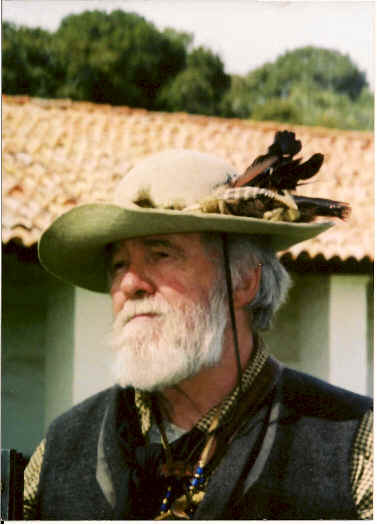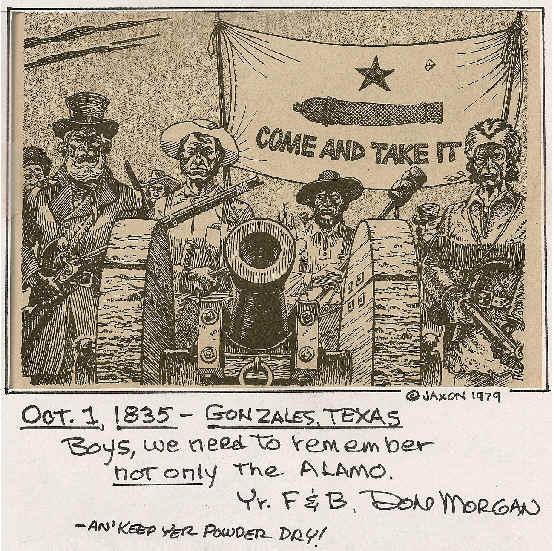|
.....
|
|

BILL
CUNNINGHAM
Captain
- Staff Writer
|
Smoke Signals
Mar./Apr. '09
|
___________________________
FROM
THE CAPTAINíS CORNER
By now, everyone, at least
those who have maintained current addresses with the
organization, should have received a nice, informative letter
that contained the information of how to access the Smoke
Signals magazine and news about the NAF, including this
yearís annual rendezvous.
I am enthused about the
opportunity to participate with the Anasazi Free Trappers.
They have offered to provide us with a separate camp area of
our own and invited us to hang out our flags and pennants.
These are very gracious folks. I have attended some of their
events over the past 12 years and have always found them to be
gracious, not to say friendly and extremely well organized. I
hope you will be able to attend.
I realize there can be
difficulties with maintaining a feeling of comradeship within
an organization as small as ours is at the moment. We have
members spread over a vast geographical area and that means
that in any given location there may be only one member. In a
few areas in particular members are several hundred miles
apart. It sounds like a flaccid thing to say in asking that
you nonetheless contact your area booshway and encourage him
to get a camp going that you may attend with other members and
friends. But I do encourage you to try. At the very least,
contact your booshway for a talk and for news. Find out who
the other members in your area are and get in touch with them,
also, if only to say hello and ask what they are doing. Share
ideas and experiencesóit can be informative and fun. If you
donít know who any of these people are, call the Chief
Factor, Ken (Howdy) Davis, or the Secretary/Treasurer, Don
Morgan, or me. Our phone numbers are: (Howdy) 970-824-6109,
Don Morgan, 805-390-4677, or me, 970-240-6090.
For those of you who
havenít received notification of the website redesign, it is
being done by Daniel and Elaine Thompson. By the time they are
finished I believe you will find that it is a user friendly site
that will be a pleasure to visit. In the interim, Buck Connor
has set the Smoke Signals, or on line magazine up as a
separate entity. That address is in the snail mail letter
referred to above. He is working hard in assisting the managing
editor, Pat Quilter, to provide an interesting and informative
publication for you. I urge you to take the time to help them
out by writing down your experiences and research and submitting
them to the magazine for publication. Everyone enjoys hearing
about the camps and treks others have taken and they usually
learn something from them. Research reports are always
interesting and make for fascinating reading. Your help is
really needed.
Until
next issue, I remain
Yr Obít &tc
Bill
Cunningham
___________________________
|

Don
Morgan
Secretary/Treasurer
|

|
MESSAGE
FROM THE SECRETARY/TREASURER.
A - ho, NAF Brothers and
Sisters,
Reading anything a
treasure has to say is, to most people, about as interesting
as watching paint dry. However, a very important fact
needs to be noted. Henceforth, all checks incoming to
NAF must be made out to DON MORGAN, and noted NAF on the memo
line of the check. Otherwise, checks can not be
deposited into the account. Please get the word out.
Now I will ruminate on
a subject I do find interesting, a personal passion in fact.
The subject of knives.
Our good friend Rex Allen
Norman attests that every Mountain Man packed a "butcher
knife", a knife that has changed little in its form
from the late 1700s to the present period. Made in the
hundreds of thousands in the great cutlery centers of
Sheffield and Birmingham, it was one of the premier
trade items on the frontier and in the far west. The
American cutlery industry hadn't yet kicked into high gear,
and on the Eastern frontier, from New England to Georgia,
blacksmiths were called upon to produce good stout
"butcher" or "hunting" knives from old
files, buggy springs and the like. Ref. Madison
Grant's "The Knife In Homespun America"
Davy Crockett, in his
autobiography, refers to his knife as "Big Butcher",
although it is known that he also carried a double edged
sticker. Did the term "butcher" refer to the form or
the function? Was a butcher only a
full or three quarter tang blade pinned to hardwood slab
handles like the English trade butcher, or a forged from a
file blade, rat tailed tang, and stuck in an antler handle as
carried by a long hunter? Or either?
In the Rockies, Old
Bill Williams refers to his "long butcher knife" as
"this yar Toothpicker" (Alpheus H Favour). Was
it pointed? In Uncle Dick Wooton's biography, by Howard
Conrad, there is an account of mountain man Jim Baker, his
rifle left in camp, killed not one but two young grizzlies
with only his "butcher" knife. A busy
morning, a brave heart, and certainly a stout knife.
Francis Parkman speaks of
the mountain men with whom he traveled caring butcher knives.
Now if we sit and study a
typical butcher knife, which we are assuming (careful!)
is approximately the same shape as those carried by red
men and white alike, one thing is obvious. This is
NOT made as a "sticker" . For skinning and
slicing, an admirable tool. but not a first choice self
defense weapon. The afore mentioned Jim Baker was a
skilled blacksmith, and several knives made by him exist in
museum collections (Carl P Russell "Firearms Traps and
Tools of the Mountain Men") and the larger one
shown, with a pretty stout clipped blade could be
called a butcher knife, I suppose.
So, our Mountain Man is
packing his Sheffield trade butcher for utility. Only
one knife? I don't think so, Millers paintings not
withstanding. What would he want at hand when his single
shot rifle and one or two pistols, went dry?
It's a fact that trappers
in the Southern Rockies, from earliest fur trade days, liked
wintering in Taos. Now, we've all read how our Anglo
Saxon trappers and traders scorned anything Mexican, and that
no trapper dressed "Southwest" ever showed up at a
rendezvous, or at least none were ever recorded.
However, we do know that the trappers greatly admired,
and sometimes married Taos women, and were grateful for
Aguardiente til the American whiskey still produced "Taos
Lightin".
All this to say I cannot
believe the Anglo trapper, for all his prejudices, would
eschew the qualities of the native Belduque. The
belduque came unto the Southwest, Texas to California, as a
Spanish not Mexican form, and could be found in all sizes.
The type originated in the Mediterranean area ,
perhaps with marine applications. The mysterious "Spanish
Notch" found on many of the blades, could have been used
as a fine strand separator for net mending, and the sharp
point and long sweeping edge would serve admirably as a fish
knife. Having been, at one time, a deck hand on a
sportfishing boat out of San Pedro, I can attest to that.
In California, where no
fire arms but for a few old escopetas, were found anywhere
except presidio garrisons and mission cuartels, the vaqueros
on the great ranchos used belduques to dispatch, or
"neck" cattle driven to the metanza, the killing
ground, for the hide and tallow trade.
Ciboleros , the buffalo
hunters of New Mexico armed with lances and bows and
arrows, carried big belduques as their principle sidearm.
Comancheros traded them in large numbers to the Comanches and
other Southern Planes tribes.
So I believe that the Anglo
trapper of the Southwest, would swallow his Yankee pride
in the name of good ol' commonsense practicality, carry the
ubiquitous butcher for utility an a stout, pointed, swept
edged belduque, forged by a talented blacksmith of Taos or
Santa Fe for the purpose of self-defense.
But then, maybe a Bowie
.....
Respectfully submitted by
Yr Humble & Ob't
S' V' T
Don
Morgan NAF #42
Page
1
 
|